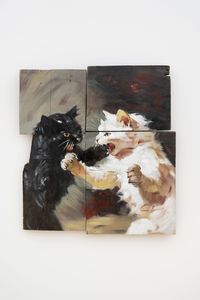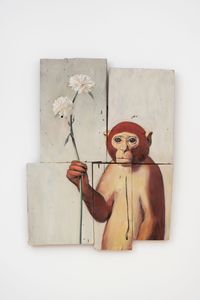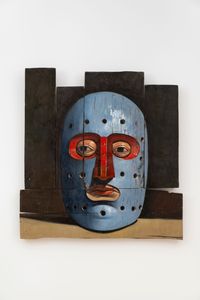


MAMOTH is delighted to announce a new solo exhibition Sometimes, Forever with Oliver Clegg. The exhibition will commence from the 22nd of March until the 4th of May.
Oliver Clegg is the ultimate jester. His aptitude for painterly play and invocations of the medium's history entwine on the makeshift canvases he assembles from scrap wood. They inscribe the work with not only the artist's immediate context, but his interest in the rehabilitative methods of Dadaism. Clegg's style can be directly linked to mid century Spanish painters such as Diego Velázquez and Jusepe de Ribera, the latter figure notable for his Caravaggistic impulse. The implementation of chiaroscuro is also a nod to the efforts of Baroquian players like Rembrandt, whose calculated tenebrism is a consistent point of reference for Clegg. By excavating the medium's past, he proves himself to be a resourceful composer of images.
In these new works, Clegg returns to the Dada approach he implemented during his studies at City & Guilds in London. The use of a school desk, with names carved and drawings scribbled, is inscribed with the ghosts of users past. Having gone through a personal loss at the time, Clegg turned to churches, schools and institutions beyond the limitations of the individual. As such, relatively academic painting is consigned to the recuperative format.
A sense of grandiosity is contrasted with throwaway surfaces, as Clegg's formal mastery meets the standards set by objet trouvé artists. This decision is centred around the framework of 'discard' in both the physical and psychological realms. Plumbing personal and conceptual histories is staged alongside the absorption of found materials. For this exhibition, aggregated wood planks were pulled from the construction site of the artist's Costa Rican home.
The center of these combines are relatively secure, their outer contours less organized. There are slight decisions in terms of assemblage, keeping within some form of structure, a basic format that lends to both landscape and portraiture. The majority, however, is left to chance. Clegg's painting thus commences without an overwrought concern for surface, toggling the uneven levels in order to create his selection of images. When appraised from different positions under gallery lighting, the viewer meets nodes that counter the flatness of a standard canvas. Practicality and opticality are at the fore of his artistic stance, as he curates the lighting and pictorial situations of his stance.
In his willingness to glide between different compositional frameworks, Clegg finds a singular position within the field of painting. He explores the tensions between tradition and Dadaism. Described by Robert Storr as 'picture-plane- puncturing techniques,' the umbrella of chiaroscuro is a model that Clegg often returns to. Driven by his own colourblindness, he seeks alternative modes forcomposing, ultimately seeing form before colours and engaging with an overwhelmingly earthy palette. Surrealism, too, is expressed through the observation of harmonies and imaginative situations. Clegg sets aspects of daily life slightly askew, like a bottled seascape and armed chicken.
It should be unsurprising that images are of constant concern for the artist. Previous bodies of work revolved around multifarious cat paintings, Happy Meal toys sourced from ebay listings, and cartoon characters in balloon form. In the case of Sometimes, Forever, the emotional panopoly contained within the painter manifests itself in Clegg's specific image selection process. Rather than stage the exhibition around a particular concept, he delves into subjectivity. Clegg maintains an enthusiastic attitude toward his lot in life. Outlook is everything; as soon as one admits there are more golden eggs on the horizon, good fortune can transpire. Though this proverbial egg is laid by geese, Clegg intends to credit a chicken with his personal kismet. There's also doubt expressed in the painting Soup of the day. The owl motif connotes wisdom - false or otherwise—while a pub beer alludes to the building up of courage. The patently artificial strength engendered by intoxication dampens the bird's sapient implication.
The seduction of these paintings is yet another critical facet for Clegg. Through the renderings of risible subjects alongside glass and metal, he weaves humour and desire together, arriving at temperamentally evasive image worlds. In I'm afraid that idiots can't be hypnotised, a ceramic heart glistens within the cropped pair of anonymous hands, culminating in attraction and sentimentalism alike. Alternatively, Give orange me give eat orange me eat orange give me eat orange give me you, sees its sympathetic protagonist clutches a double-bloomed stem. This monkey appears dejected, but unable to shake his longing for love.
Despite their contrasts, a marked consistency inscribed within Clegg's selection of paintings for Sometimes, Forever. A particular rhythm characterises the show, one that is set by the artist's eccentricities and adroitness.
Press release courtesy MAMOTH, London. Text: Reilly Davidson.
3 Endsleigh Street
London, WC1H 0DS
United Kingdom
The gallery is temporarily closed until further notice.
Wednesday–Saturday: 12–6pm